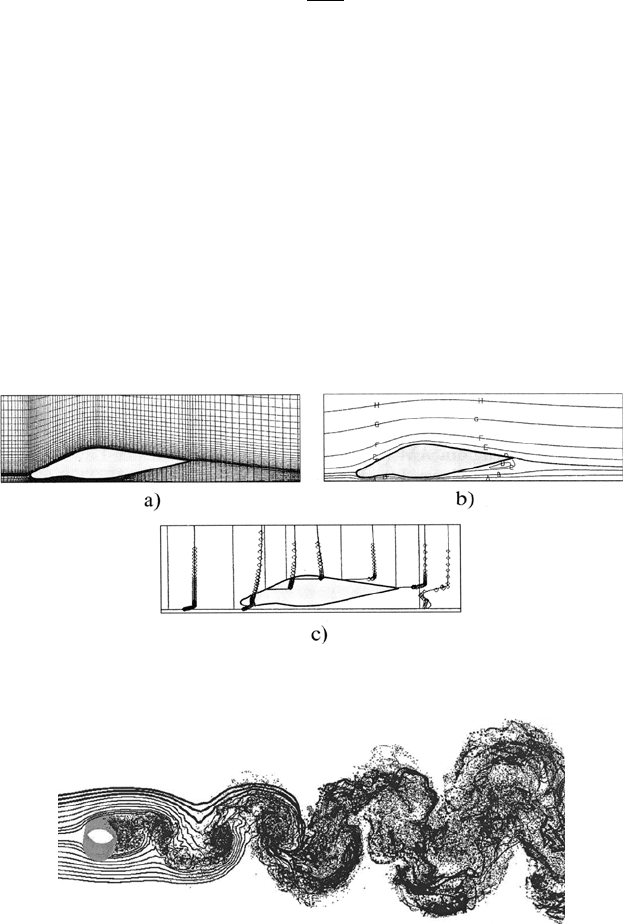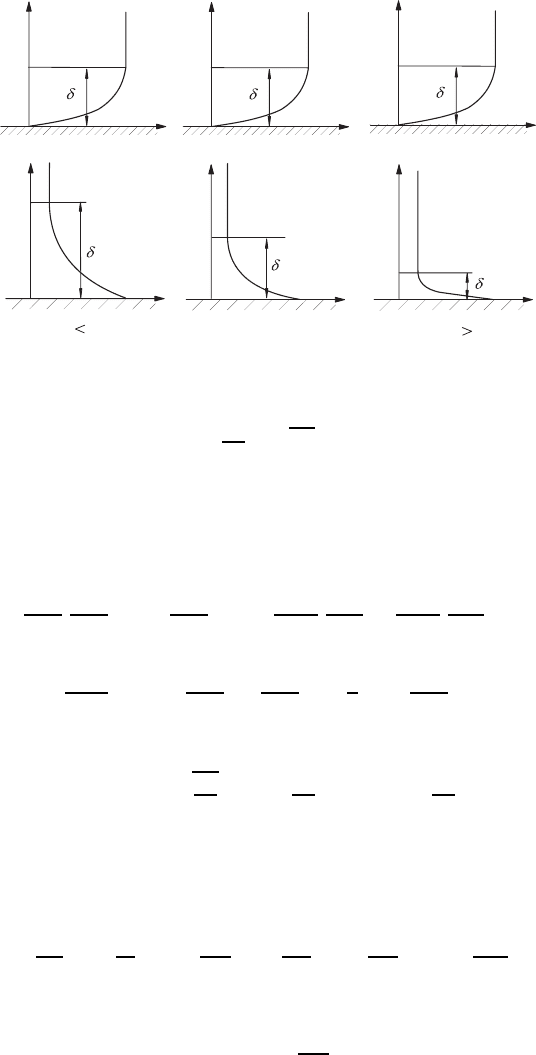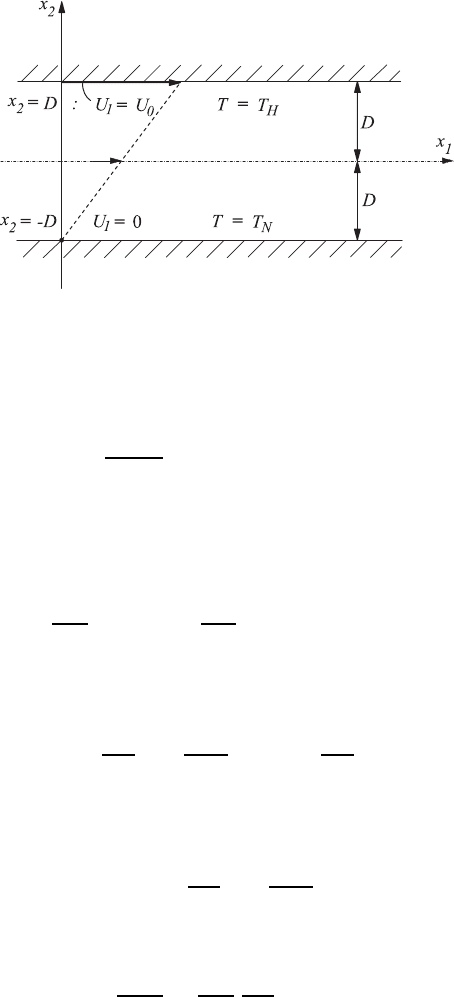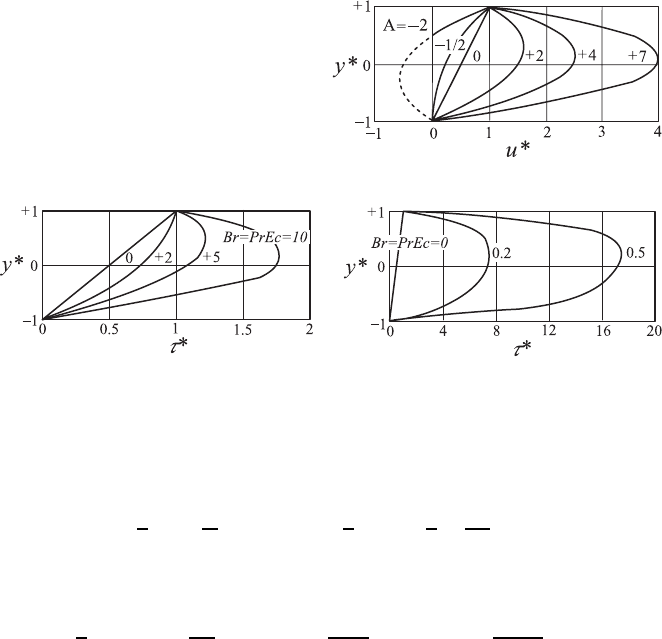Durst F. Fluid Mechanics: An Introduction to the Theory of Fluid Flows
Подождите немного. Документ загружается.


624 19 Numerical Solutions of the Basic Equations
where the velocity gradient is derived from the logarithmic law (19.129) and
the local shear tension is set equal to the wall shear stress.
The dissipation rate, which appears in the k equation (19.121), is
approximated by assuming a linear dependence of the near-wall length scale:
L =
k
3/2
=
κ
c
3/4
µ
n. (19.137)
Equation (19.137) holds under local equilibrium conditions and for a logarith-
mic velocity law. From this follows an equation for in the near-wall control
volume in the form
c
= c
3/4
µ
k
3/2
c
κn
c
. (19.138)
19.6.2.5 Dissipation Rate
According to the treatment of boundary conditions in practice, for the dis-
sipation rate , its value is determined at the first computational node away
from the wall by employing (19.138).
19.6.2.6 Symmetry Planes
Along the symmetry planes (or symmetry lines) of flow, the standard gradi-
ents (diffusive flows) of the dependent variables and the normal velocity U
n
are set equal to zero:
∂U
s
∂n
= U
n
=
∂T
∂n
=
∂k
∂n
=
∂
∂n
=0. (19.139)
19.6.2.7 Inflow Planes
Usually inlet flow profiles are derived from experimental data or from other
empirical information and are employed as inflow conditions. The turbu-
lence quantities often refer to the inflow velocity U
in
by specifying a relative
turbulence intensity Tu, defined as
Tu=
u
2
U
in
. (19.140)
Typical values for Tu lie between 1 and 20%. For an isotropic turbulent flow,
Tu is related to k through
k =
3
2
(TuU
in
)
2
. (19.141)

19.6 Computations of Turbulent Flows 625
At the inflow plane dissipation rates can be specified, assuming that the
quantity of the larger turbulence vortices is proportional to a typical scale of
length H of the cross flow area, i.e.
=
k
3/2
aH
. (19.142)
Characteristic values for the proportional factor a are of the order of
magnitude of 0.01–1.
19.6.2.8 Outflow Planes
The same approach as described in Sect. 19.5.4, is usually employed for out-
flow planes. In addition to the equations stated there, the gradients of k and
assigned to the flow direction are set to zero.
The above equations can now be solved numerically for two-dimensional
flows, including the indicated boundary conditions. For the illustration
of typical computational results, different flow problems are shown in
Figs. 19.16–19.18.
Fig. 19.16 Flows around a near-ground model vehicle – computational result – LDA
measurements
Fig. 19.17 Subcritical flow around a circular cylinder at Re =3,900; Breuer (2002)

626 19 Numerical Solutions of the Basic Equations
(a) (b)
Fig. 19.18 Separated flow around a wing at Re =20,000; (a) non-stationary
rotational-power distribution; (b) time-averaged streamlines; Breuer (2002)
References
19.1. Sch¨afer, M.: Numerik im Maschinenbau, Springer, Berlin Heidelberg New York,
1999
19.2. Cebeci, T. and Bradshaw, P.: Physical and Computational Aspects of Convec-
tive Heat Transfer, Mei Ya Publications, Springer, Berlin Heidelberg New York,
Tokyo, 1984
19.3. Ferziger, J.L. and Peric, M.: Computational Methods for Fluid Dynamics, 2nd
revised edition, Springer, Berlin Heidelberg New York, 1999
19.4. Peyret, R. and Taylor, T.D.: Computational Methods for Fluid Flow, Springer
Series in Computational Physics, Springer, Berlin Heidelberg New York, 1983
19.5. Wilcox, D.C.: Turbulence Modeling, DCW Industries, Griffin Printing,
Glendale, CA, 1993
19.6. Laundes, B.E. and Spalding, D.B.: Mathematical Models of Turbulence,
Acadmic Press, London (1972)

Chapter 20
Fluid Flows with Heat Transfer
20.1 General Considerations
The derivations carried out in Chap. 5 to yield the basic equations of fluid
mechanics also include considerations of the energy transport and, based on
these considerations, different forms of the energy equation were derived.
There it could be shown that the local mechanical energy equation, stated as
a differential equation for a fluid, does not represent an independent equation,
as it can be derived from the generally formulated momentum equation. This
was the reason to subtract this equation from the total energy equation, in
order to obtain the thermal energy equation that can be written as follows:
ρ
∂e
∂t
+ U
i
∂e
∂x
i
= −
∂ ˙q
i
∂x
i
− P
∂U
i
∂x
i
− τ
ij
∂U
j
∂x
i
, (20.1)
where ρ is the density of the fluid, e its inner energy, t the time, U
i
the fluid
velocity, ˙q
i
the heat flux, P the pressure and τ
ij
the molecular-dependent
momentum transport. This equation can now be employed for a thermody-
namically ideal fluid, i.e. for ρ = constant and thus for (∂U
i
/∂x
i
) = 0, and
also for
˙q
i
= −λ
∂T
∂x
i
and τ
ij
= −µ
∂U
j
∂x
i
+
∂U
i
∂x
j
(20.2)
in the following form for heat transfer computations, where c
v
= c
p
= c =
was taken into consideration because of ρ = constant:
ρc
∂T
∂t
+ U
i
∂T
∂x
i
= λ
∂
2
T
∂x
i
2
+ µ
∂U
j
∂x
i
2
. (20.3)
Together with the continuity equation:
∂U
i
∂x
i
= 0 (20.4)
627

628 20 Fluid Flows with Heat Transfer
and the momentum equations for j =1, 2, 3:
ρ
∂U
j
∂t
+ U
i
∂U
j
∂x
i
= −
∂P
∂x
j
+ µ
∂
2
U
j
∂x
i
2
+ ρg
j
(20.5)
one obtains a system of five differential equations for the five unknowns U
1
,
U
2
, U
3
, P and T , which can be solved with suitable boundary conditions.
Thus, flow problems can be solved that occur coupled with heat-transfer
problems, but do not lead to considerable modifications of the fluid properties
such as ρ, µ and λ. This is often the case in technical applications of fluid
mechanics, where the actual fluid flow processes are sometimes of secondary
importance, the main importance being given to the heat transfer and heat
dissipation of a system. This significance of heat transfer is the actual reason
for including the present chapter in a book on fluid mechanics. It serves as
an introduction for students of fluid mechanics into an important field of
applications of fluid-mechanical know-how.
In order to present, in an easily understandable way, some general proper-
ties of heat transfer, as compared with momentum transfer, equations (20.3)
and (20.5) are rearranged:
∂T
∂t
+ U
i
∂T
∂x
i
=
λ
ρc
∂
2
T
∂x
i
2
+ ν
∂U
j
∂x
i
2
with
ν
Pr
=
λ
ρc
(20.6)
and
∂U
j
∂t
+ U
i
∂U
j
∂x
i
= ν
∂
2
U
j
∂x
i
2
+ ρg
j
−
∂P
∂x
j
, (20.7)
where ν is the viscous diffusion coefficient and a = λ/ρc is the thermal
diffusion coefficient. From their interrelationship, the Prandtl number results:
Pr =
ν
a
=
µ
ρ
ρc
λ
=
µc
λ
which expresses how the molecular-dependent momentum transport relates
to the molecular-dependent heat transport. The Prandtl number can thus
be employed to demonstrate in which way momentum transport and heat
transport relate relatively to one another.
For small Pr, e.g. for metallic melts for equal development lengths, the
thermal boundary layer of a plate flow has developed more intensely than
the “velocity boundary layer” (Fig. 20.1).
The facts illustrated in Fig. 20.1 can also be expressed in development
lengths for momentum and temperature boundary layers, such that for δ
u
=
δ
T
the following relationships hold:
L
T
√
a
=
L
U
√
ν
;
L
U
L
T
=
0
ν
a
=
√
Pr. (20.8)
For equal development length, the following results for the boundary layer
thicknesses can be derived:

20.1 General Considerations 629
y
U(y)
u
y
U(y)
u
y
U(y)
u
T
y
yy
T(y)
T(y)
T(y)
Pr
1
Pr
1
Pr
1
=
T
T
Fig. 20.1 Thicknesses of temperature-boundary layers for different Prandtl numbers
δ
U
δ
T
=
√
Pr. (20.9)
This means that the molecular-dependent momentum transport is larger than
the molecular-dependent heat transport when Pr > 1 (see Fig. 20.1).
When extending the similarity considerations in Chap. 7, where from the
dimensionless momentum and τ
ij
transport equations:
ρ
∗
*
!
c
U
c
t
c
∂U
∗
j
∂t
∗
+ U
∗
i
∂U
∗
j
∂x
∗
j
+
= −
∆P
ρ
c
U
2
c
∂P
∗
∂x
∗
j
−
τ
w
ρ
c
U
2
c
∂τ
∗
ij
∂x
∗
i
, (20.10)
τ
∗
ij
=
µ
c
U
c
τ
w
!
c
3
−µ
∗
*
∂U
∗
j
∂x
∗
i
+
∂U
∗
i
∂x
∗
j
+
+
2
3
µ
∗
δ
ij
∂U
∗
k
∂x
∗
k
4
(20.11)
the following characteristic quantities of a flow can be derived:
u
c
= u
τ
=
0
τ
w
ρ
,!
c
=
ν
u
τ
and t
c
=
ν
u
2
τ
. (20.12)
When carrying out corresponding considerations for the energy equation, one
obtains the following derivations:
• Energy equation:
ρc
p
∂T
∂t
+ U
i
T
x
i
= −
∂q
i
∂x
i
+
∂P
∂t
+ U
i
∂P
∂x
i
− τ
ij
∂U
j
∂x
i
. (20.13)
• Fourier law of heat transfer
q
i
= −λ
∂T
∂x
i
. (20.14)

630 20 Fluid Flows with Heat Transfer
• Dimensionless form of energy equation:
ρ
∗
c
∗
p
!
c
t
c
U
c
∂T
∗
∂t
∗
+ U
∗
i
∂T
∗
∂x
∗
i
= −
˙q
c
ρ
c
(c
p
)
c
∆T
c
U
c
∂ ˙q
∗
i
∂x
∗
i
−
∆P
c
ρ
c
(c
p
)
c
∆T
c
!
c
t
c
U
c
∂P
∗
∂t
∗
+ U
∗
i
∂P
∗
∂x
∗
i
−
τ
w
ρ
c
c
p,c
∆T
c
τ
∗
ij
∂U
∗
j
∂x
∗
i
. (20.15)
• Characteristic temperature difference and characteristic heat transport:
∆T
c
=
τ
w
ρ
c
(c
p
)
c
and ˙q
c
= τ
w
U
c
. (20.16)
• Characteristic units of length and time:
˙q
c
q
∗
i
= −
λ
c
∆T
c
!
c
λ
∗
∂T
∗
∂x
∗
i
; !
c
=
λ
c
∆T
c
˙q
c
=
λ
c
ν
c
µ
c
(c
p
)
c
U
c
=
1
Pr
ν
c
u
τ
(20.17)
so that !
T
= !
U
/P r holds and t
T
= t
U
/P r . These derivations represent the
facts stated in Fig. 20.1 and in (20.8). These facts will turn up again in the
examples cited in the subsequent representations of flows with heat transfer.
20.2 Stationary, Fully Developed Flow in Channels
A simple flow with heat transfer is the stationary fully developed flow in
channels with a wall in motion. In Fig. 20.2, the basic geometry of the two-
dimensional version of this flow is sketched, and the boundary conditions are
also stated. For this flow, the following equations for two-dimensional flows
hold, given below for ρ = constant and for constant viscosity and constant
heat conductivity:
∂U
1
∂x
2
+
∂U
2
∂x
2
=0, (20.18)
ρ
∂U
1
∂t
+ U
1
∂U
1
∂x
1
+ U
2
∂U
1
∂x
2
= −
∂P
∂x
1
+ µ
∂
2
U
1
∂x
1
2
+
∂
2
U
1
∂x
2
2
+ ρg
1
,
(20.19)
ρ
∂U
2
∂t
+ U
1
∂U
2
∂x
1
+ U
2
∂U
2
∂x
2
= −
∂P
∂x
2
+ µ
∂
2
U
2
∂x
1
2
+
∂
2
U
2
∂x
2
2
+ ρg
2
,
(20.20)
ρ
c
∂T
∂t
+ U
1
∂T
∂x
1
+ U
2
∂T
∂x
2
= λ
∂
2
T
∂x
1
2
+
∂
2
T
∂x
2
2
+ µ
3
∂U
1
∂x
1
2
+
∂U
2
∂x
2
2
+
∂U
1
∂x
2
2
+
∂U
2
∂x
1
2
4
.
(20.21)

20.2 Stationary, Fully Developed Flow in Channels 631
and
and
Fig. 20.2 Plane flow in a channel with one wall in motion and with wall temperatures
T
H
and T
N
Because of the assumed stationarity of the overall problem, the following
holds:
∂ (···)
∂t
= 0 for all quantities
and moreover also (∂U
i
/∂x
1
) = 0, due to the fully developed flow in the x
2
direction and (∂T/∂x
1
) = 0, as the temperature field also is assumed to be
fully developed.
With the above assumptions, one obtains from the continuity equation:
∂U
1
∂x
1
=0 ;
∂U
2
∂x
2
=0 ; U
2
=0. (20.22)
Equations (20.19) and (20.20) reduce for the flow sketched in Fig. 20.2 to the
following forms:
0=−
∂P
∂x
1
+ µ
∂
2
U
1
∂x
2
2
;0=−
∂P
∂x
2
− ρg. (20.23)
From (20.23) P (x
1
,x
2
)=−ρgx
2
+ Π(x
1
), and thus the equation for the
velocity field can be written as:
0=−
dΠ
dx
1
+ µ
d
2
U
1
dx
2
2
. (20.24)
Standardization of this equation with x
∗
2
= x
2
/D and U
∗
1
= U
1
/U
0
yields:
d
2
U
∗
1
dx
∗
2
2
=
D
2
µU
0
dΠ
dx
1
= −A. (20.25)
For the energy equation (20.21), assuming stationarity and a fully developed
temperature field, one obtains:

632 20 Fluid Flows with Heat Transfer
0=λ
d
2
T
dx
2
2
+ µ
dU
1
dx
2
2
. (20.26)
This equation yields with T
∗
=(T − T
N
)/(T
H
− T
N
), with T
H
= the high
wall temperature and T
N
= the low wall temperature,
d
2
T
∗
dx
∗
2
2
= −
µU
2
0
λ (T
H
− T
N
)
dU
∗
1
dx
∗
2
2
, (20.27)
where the normalization factor on the right-hand side represents the
Brinkmann number:
Br =
µU
2
0
λ (T
H
− T
N
)
=
µc
λ
U
2
0
c (T
H
− T
N
)
= PrEc (20.28)
with Pr =
µc
λ
(Prandtl number) and Ec =
U
2
0
c(T
H
− T
N
)
(Eckert number).
Integration of (20.25) yields
dU
∗
1
dx
∗
2
= −Ax
∗
2
+ C
1
; U
1
= −
A
2
x
∗2
2
+ C
1
x
∗
2
+ C
2
. (20.29)
With the boundary conditions x
∗
2
= −1, U
∗
1
=0andx
∗
2
=1,U
∗
1
=1,one
obtains for the integration constants C
1
=
1
2
and C
2
=
1
2
(A + 1). Thus the
equation for the normalized velocity distribution reads
U
∗
1
=
1
2
(1 + x
∗
2
)+
1
2
A
!
1 − x
∗2
2
"
. (20.30)
This equation expresses that the resulting velocity distribution is composed of
the Couette flow
1
2
(1+x
∗
2
)movedbyU
0
and the pressure-driven Poiseuille flow
1
2
A(1−x
∗2
2
). The linear differential equation (20.25) leads to the superposition
of the Couette and Poiseuille flows.
In order to obtain the solution of the normalized temperature equation,
one first computes the velocity gradient:
dU
∗
1
dx
∗
2
=
1
2
− Ax
∗
2
. (20.31)
With (20.27), one obtains the following differential equation for the
temperature distribution:
d
2
T
∗
dx
∗
2
2
= −Br
1
4
− Ax
∗
2
+ A
2
x
∗2
2
. (20.32)
On integrating this equation, one can derive
T
∗
= −Br
1
8
x
∗2
2
−
A
6
x
∗3
2
+
A
2
12
x
∗4
2
+ C
1
x
∗
2
+ C
2
. (20.33)

20.3 Natural Convection Flow 633
Fig. 20.3 Velocity profiles for different
values of A
Fig. 20.4 Temperature profiles for different Brinkmann numbers
With the boundary conditions x
∗
2
= −1, T
∗
=0andx
∗
2
=1,T
∗
=1,onecan
derive for the integration constants C
1
and C
2
:
C
1
=
1
2
− Br
A
6
and C
2
=
1
2
+ Br
1
8
+
A
2
12
. (20.34)
Equations (20.34) inserted in (20.33) yield, after rearranging the terms,
T
∗
=
1
2
(1 + x
∗
2
)+
Br
8
!
1 − x
∗2
2
"
−
BrA
6
!
x
∗
2
− x
∗3
2
"
−
BrA
2
12
!
1 − x
∗4
2
"
.
(20.35)
The resulting temperature distribution shows a first term corresponding to
the pure heat conduction, i.e. a linear change of the temperature from T
N
at the lower non-moving wall to T
H
at the upper moving wall. The second
term results from the dissipative heat due to the linear velocity profile of the
Couette flow and the remaining terms from the dissipation shear of the flow,
which results from the parabolic velocity profile of the Poiseuille flow.
The velocity and temperature profiles that followed from the above deriva-
tions are shown in Figs. 20.3 and 20.4 for different parameters A and Br.
20.3 Natural Convection Flow Between Vertical Plane
Plates
In the preceding sections, flows were considered for which it was assumed
that the fluid properties, such as the density ρ, the dynamic viscosity µ and
the heat conduction λ, are constant. They could therefore be considered as
